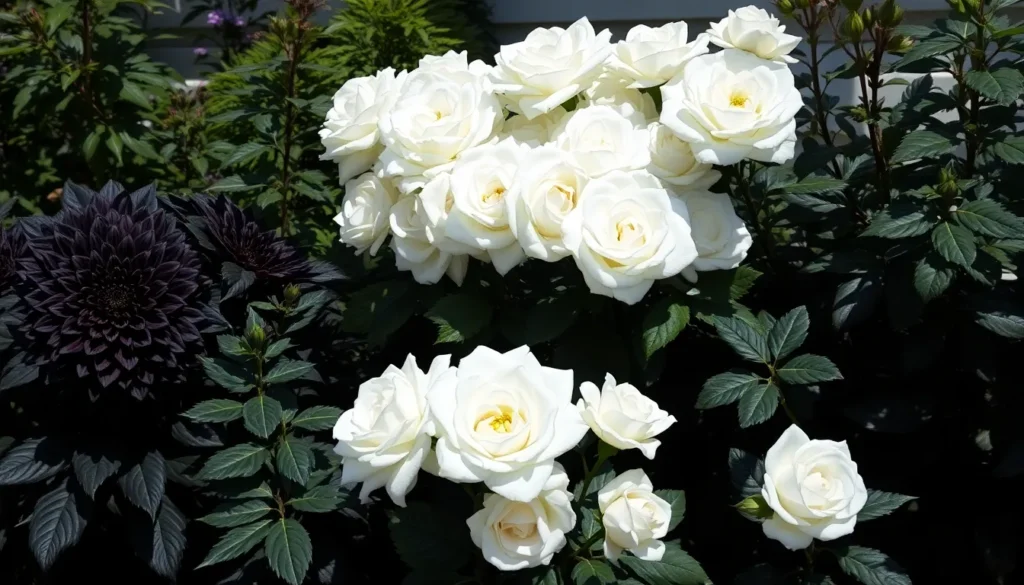Black and white plants captivate us with their striking monochromatic beauty that transforms any garden into a sophisticated masterpiece. We’ve discovered that these dramatic color combinations create stunning visual contrast while offering endless design possibilities for both indoor and outdoor spaces.
Whether you’re drawn to the deep obsidian foliage of black petunias or the pristine white blooms of moonflowers, we’ll show you how these remarkable plants can elevate your gardening game. From the gothic elegance of black hollyhocks to the timeless appeal of white roses, these plants prove that sometimes the most powerful statements come in the simplest colors.
We’re excited to share our expertise on selecting, growing, and designing with these show-stopping plants that’ll make your neighbors stop and stare. Get ready to discover how black and white botanicals can transform your garden into a photographer’s dream.
Dramatic Black Foliage Plants That Command Attention
Moving beyond flowering plants, we discover that foliage varieties offer equally stunning dark drama for our gardens. These commanding specimens create year-round visual impact through their distinctive leaf coloration.
Black Pearl Ornamental Pepper
Black Pearl ornamental peppers transform garden beds with their deep purple-black foliage and glossy black fruits. We’ve found these compact plants reach 18-24 inches tall and wide, making them perfect for borders or container displays. The dark leaves provide a striking backdrop for the small white flowers that appear in summer, followed by round black peppers that maintain their color throughout the growing season.
Growing requirements for Black Pearl peppers include full sun exposure and well-draining soil with temperatures above 60°F. We recommend starting seeds indoors 8-10 weeks before the last frost date, then transplanting outdoors once soil warms. These heat-loving plants thrive in USDA zones 9-11 as perennials but perform beautifully as annuals in cooler climates.
Design applications showcase Black Pearl peppers as excellent accent plants in mixed borders or as dramatic focal points in monochromatic gardens. We often pair them with silver foliage plants like dusty miller or white flowering annuals to create stunning contrast combinations.
Black Elephant Ear (Colocasia)
Colocasia ‘Black Magic’ delivers tropical drama with its enormous heart-shaped leaves in deep purple-black tones. We’ve measured mature leaves reaching 2-3 feet across on plants that can tower 4-6 feet tall, creating impressive architectural statements in industry designs. The glossy leaf surface reflects light beautifully, adding depth and dimension to shaded garden areas.
Cultivation needs include partial shade to filtered sunlight and consistently moist, rich soil with good drainage. We plant tubers in spring after soil temperatures reach 65°F, spacing them 3-4 feet apart to accommodate their substantial mature size. These tropical plants require regular watering and benefit from monthly fertilizing during the growing season.
Industry uses position Black Magic elephant ears as spectacular specimen plants near water features or in bog gardens. We use their dramatic presence as backdrop plants for smaller colorful flowers or group multiple plants together for maximum visual impact in large spaces.
Black Dahlia Varieties
‘Black Beauty’ dahlias produce deep burgundy-black blooms on sturdy 4-5 foot stems, offering both striking flowers and attractive dark foliage. We’ve observed these dinner-plate varieties creating incredible focal points in late summer gardens when their 8-10 inch blooms reach peak display. The near-black petals appear almost velvety in texture, absorbing light to create mysterious garden depths.
‘Black Jack’ dahlia cultivars present smaller 4-inch blooms in rich maroon-black shades on more compact 3-foot plants. We appreciate their prolific flowering habit, producing dozens of dark blooms from midsummer through frost. These varieties work exceptionally well in cutting gardens, providing dramatic elements for floral arrangements.
Growing essentials require full sun exposure and well-amended soil with excellent drainage to prevent tuber rot. We plant dahlia tubers 4-6 inches deep after soil warms in late spring, providing sturdy stakes for taller varieties. Regular deadheading promotes continuous blooming, while weekly watering maintains optimal growth throughout the season.
Striking White Flowering Plants for Elegant Gardens
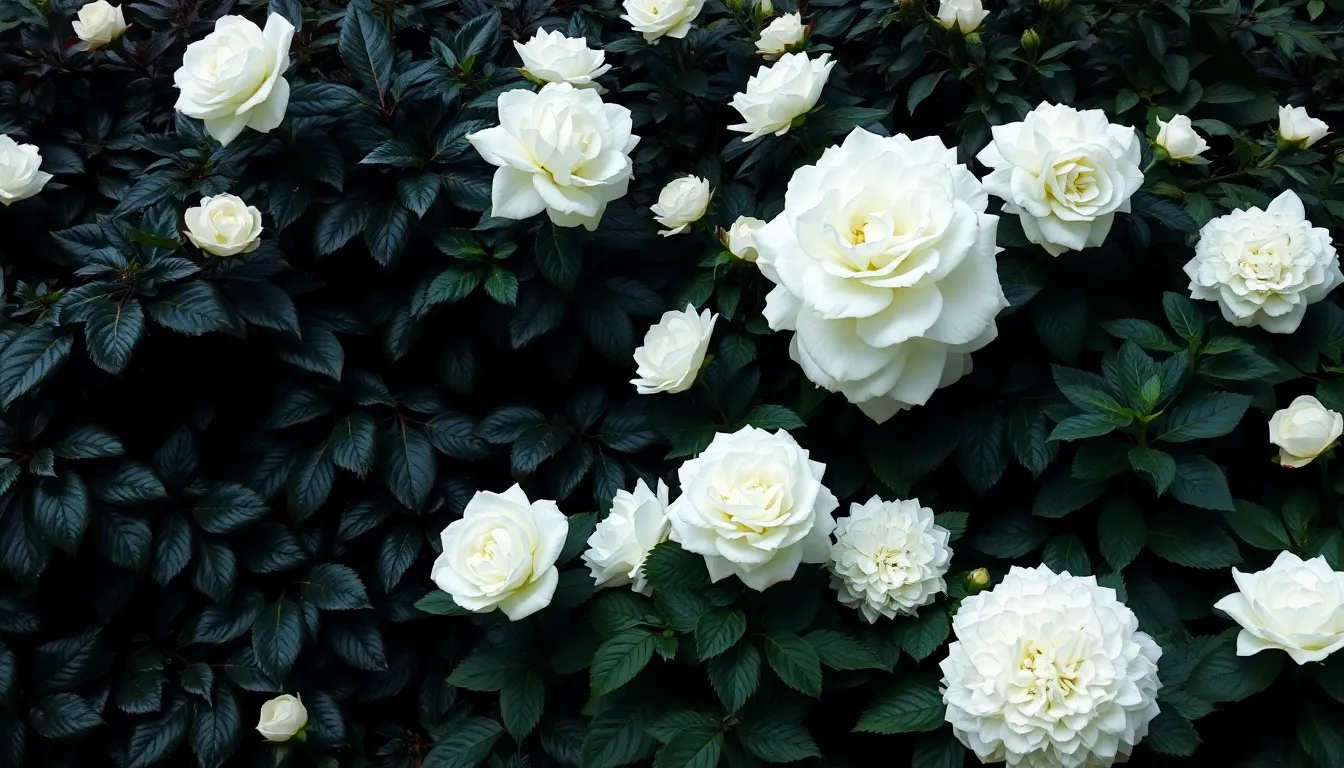
White flowering plants bring timeless elegance and sophisticated contrast to gardens dominated by dramatic black foliage. Creating a successful white garden requires selecting plants that bloom at different times throughout the season while providing varied textures and heights.
White Roses and Their Varieties
Classic white roses serve as the foundation of any elegant white garden design. Popular cultivars like ‘Iceberg’, ‘Winchester Cathedral’, and ‘Pope John Paul II’ offer exceptional fragrance and timeless beauty that complements dark architectural elements. These varieties bloom repeatedly throughout the growing season, providing consistent white blooms that maintain garden sophistication. White roses require regular deadheading to prevent browning and keep the garden looking pristine and elegant.
White Hydrangeas for Seasonal Impact
Hydrangea arborescens ‘Annabelle’ creates dramatic seasonal focal points with its large, spherical clusters of white flowers. These impressive blooms appear in summer and can fill entire garden spaces with bright white color that contrasts beautifully against dark foliage plants. The flowers bloom profusely and maintain their visual impact for extended periods, making them ideal for creating striking seasonal displays. Regular maintenance includes deadheading spent blooms to encourage continued flowering and maintain the garden’s tidy appearance.
White Orchids for Indoor Sophistication
Phalaenopsis orchids bring sleek elegance and minimalist aesthetics to indoor spaces as perfect companions to outdoor black and white gardens. These moth orchids offer sophisticated white blooms that create refined focal points in contemporary interior designs. Their long lasting flowers and architectural form make them ideal for extending the black and white garden theme indoors. White orchids thrive with consistent moisture and indirect light, requiring minimal maintenance while providing maximum visual impact.
Variegated Plants Black and White for Visual Interest
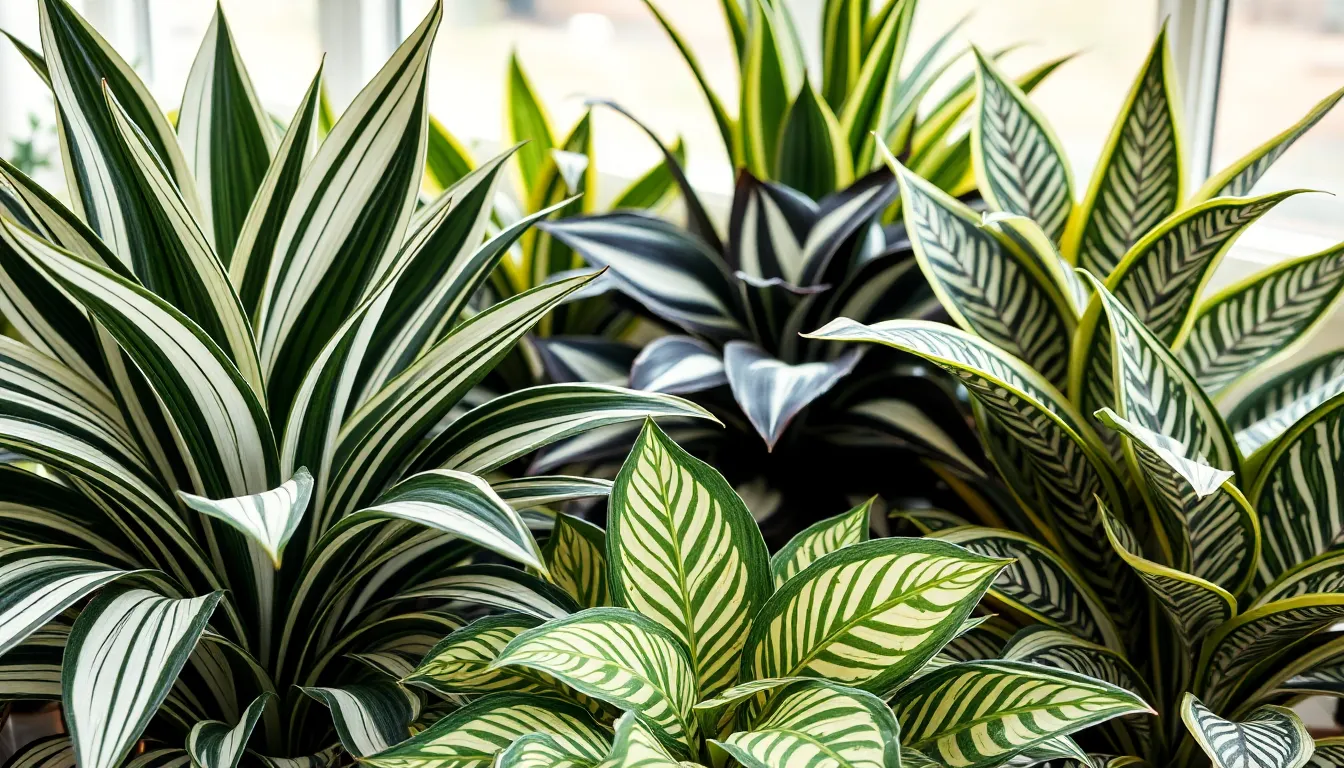
Variegated foliage brings sophisticated contrast to our gardens with leaves displaying multiple colors in striking patterns. These plants excel at creating visual drama through their bold black, white, and green combinations.
White-Striped Snake Plants
Snake plants with white striping transform any space with their architectural beauty and sword-like leaves. Sansevieria varieties feature prominent creamy white stripes or edges contrasting against dark green or nearly black foliage. Their upright growth pattern creates bold vertical lines that draw the eye upward in indoor settings.
Care benefits make these plants perfect for busy gardeners since they tolerate low light conditions and require minimal watering. Air purification qualities add functional value beyond their stunning appearance. We recommend placing them in corners or along walls where their dramatic silhouette can make the strongest impact.
Black and White Hostas
Hostas with black and white variegation create sophisticated focal points in shaded garden areas. Cultivars featuring almost black centers paired with crisp white edges deliver maximum visual contrast in low light conditions. Their broad leaves add substantial texture while brightening darker corners of our outdoor spaces.
Seasonal interest develops as these perennials emerge each spring with fresh variegated patterns. White margins or stripes against deep green or near black leaf centers enhance garden brightness throughout the growing season. Shade tolerance makes them valuable for areas where other colorful plants struggle to thrive.
Zebra Plant (Calathea Zebrina)
Calathea zebrina earns its common name through distinctive white or light green striped patterns reminiscent of zebra markings. Dark green leaves showcase these vivid stripes in dramatic fashion that transforms any indoor space. Tropical origins require us to provide humid environments with indirect light for optimal growth.
Indoor cultivation succeeds when we maintain consistent moisture and protect these plants from direct sunlight. Their dramatic foliage patterns make them popular houseplants for adding tropical flair to living spaces. Regular misting helps recreate the humid conditions these plants crave in their native habitat.
Black and White Succulents for Modern Aesthetics
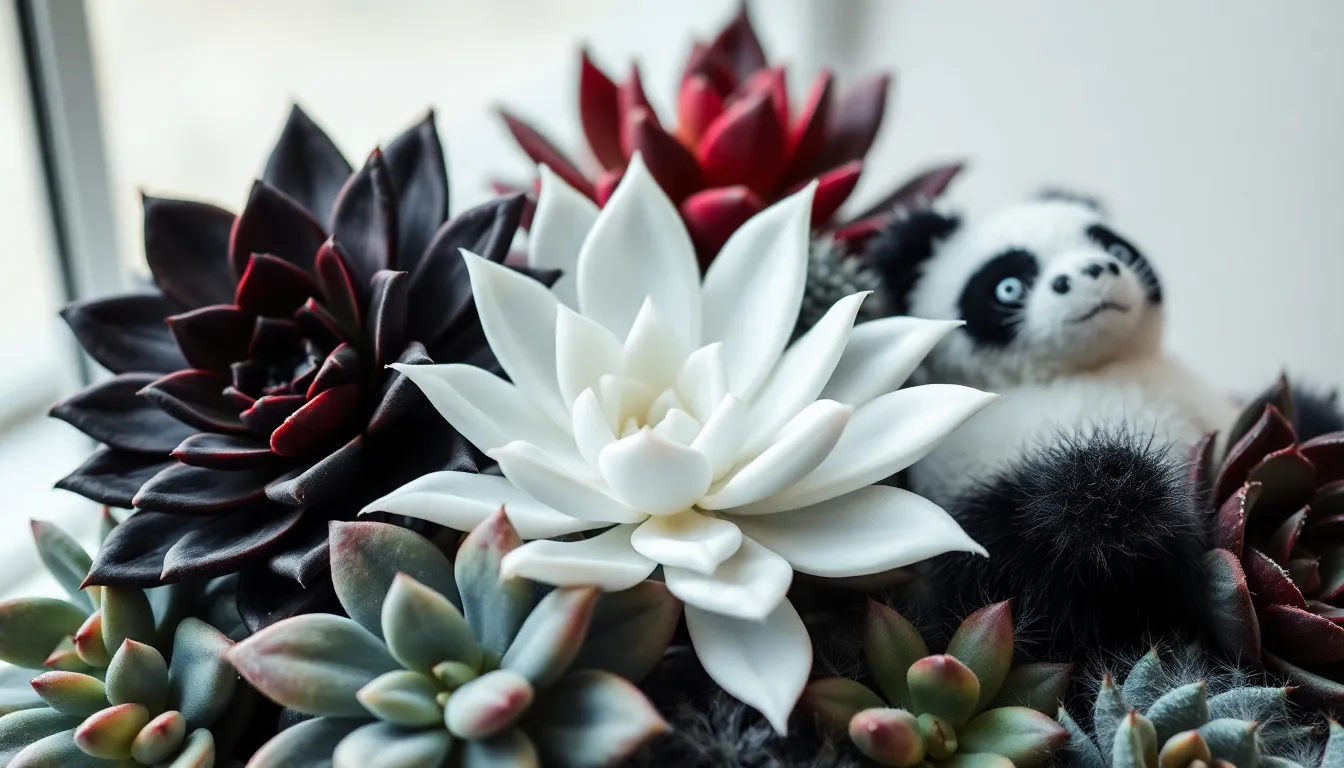
We’re moving beyond traditional flowering plants to explore the sophisticated industry of monochromatic succulents. These architectural specimens deliver striking visual impact while requiring minimal maintenance.
Black Rose Aeonium
Aeonium arboreum ‘Zwartkop’ transforms any space with its dramatic dark foliage arranged in perfect rosettes. Deep burgundy to nearly black leaves create the illusion of dark roses sprouting from sculptural stems. We recommend placing these show-stopping specimens in full sun locations where they’ll develop their most intense coloration.
Container growing works exceptionally well for these Mediterranean natives, allowing you to move them indoors during harsh winters. Garden beds in hardiness zones 9-11 provide ideal permanent homes for these architectural plants. Their bold presence makes them perfect focal points in modern industry designs or monochrome themed arrangements.
White Ghost Plant (Graptopetalum)
Graptopetalum species offer ethereal beauty with their pale, silvery white leaves that catch and reflect light beautifully. These ghostly specimens often display a subtle metallic sheen that adds sophisticated glamour to succulent collections. Bright, sunny locations bring out their most pronounced white coloration.
Multiple varieties within the Graptopetalum family showcase this coveted white pigmentation, making them rare finds among succulent enthusiasts. We’ve found these plants work wonderfully as soft counterpoints to darker specimens in mixed arrangements. Their muted tones create calming visual breaks in busy garden compositions.
Panda Plant with Black-Tipped Leaves
Kalanchoe tomentosa delivers natural black and white contrast through its fuzzy, pale leaves accented with distinctive dark tips. Soft, velvety textures invite touch while bold black edges provide sharp definition. These indoor favorites thrive in bright indirect light, making them perfect houseplants for modern interiors.
Fuzzy white surfaces create interesting textural contrast against smooth-leaved companions in succulent displays. We particularly love how their natural two-tone appearance eliminates the need for additional plants to achieve dramatic color contrast. Easy care requirements make them ideal choices for beginning succulent collectors seeking statement pieces.
Indoor Plants Black and White for Contemporary Spaces
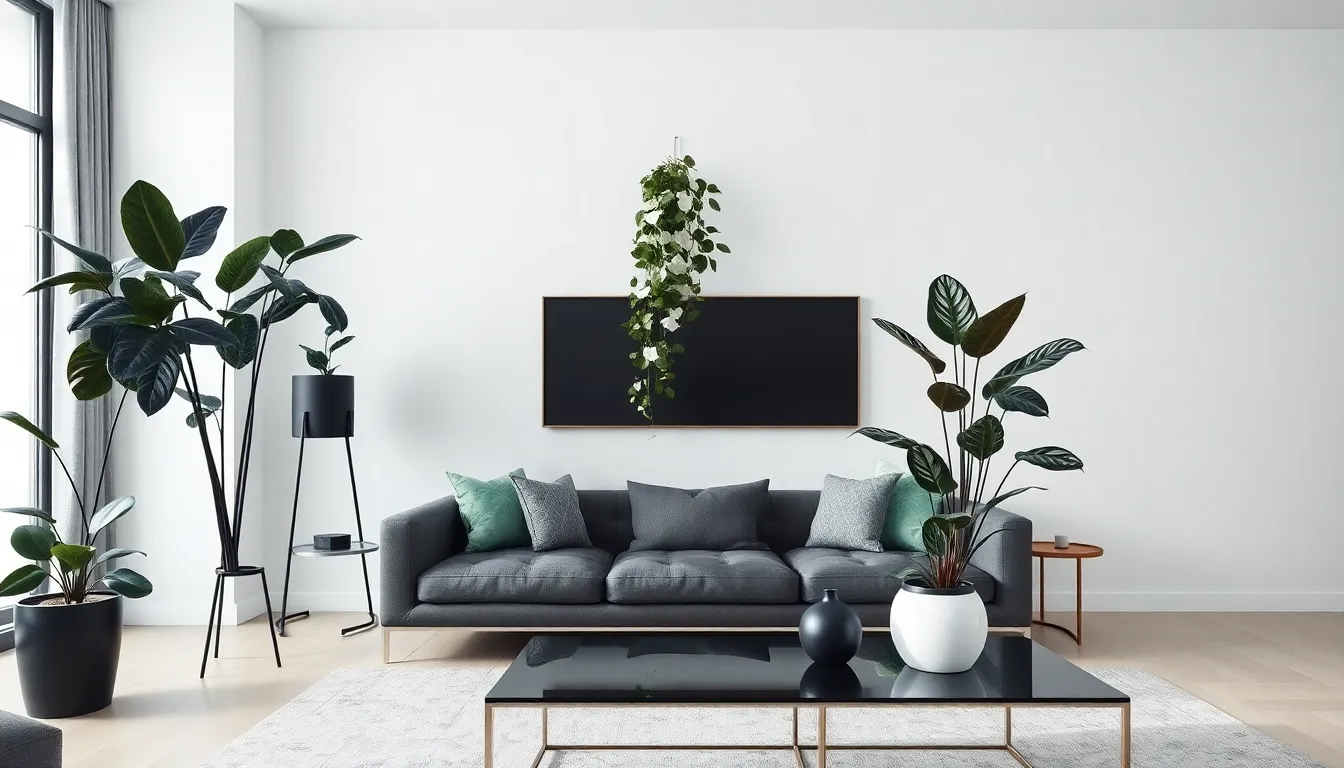
Moving from outdoor gardens to interior spaces, we find that contemporary homes benefit tremendously from the sophisticated contrast of black and white plants. These remarkable specimens transform minimalist spaces into living galleries where natural beauty meets modern design.
Black ZZ Plant (Zamioculcas Zamiifolia)
Black ZZ Plants showcase deep glossy black-green leaves that create dramatic focal points in contemporary living spaces. Their resilient nature makes them perfect for busy homeowners who want striking aesthetics without demanding maintenance schedules. We love how these architectural plants introduce vertical interest to modern rooms while softening harsh geometric lines.
Decorating with Black ZZ Plants adds sophistication to monochrome interiors through rich texture and depth. The upright growth habit complements angular furniture arrangements beautifully. Office corners and living room accents benefit from their bold presence. Low light tolerance means they thrive where other plants struggle.
Maintenance requirements remain minimal for these adaptable specimens. Watering every 2-3 weeks satisfies their drought-tolerant nature. Normal indoor temperatures between 65-75°F provide optimal growing conditions. Their glossy foliage naturally repels dust, keeping appearances sharp with minimal effort.
White Pothos Varieties
White Pothos varieties like Marble Queen and N’Joy display stunning variegated patterns that brighten contemporary spaces. Their cascading vines add flowing movement to rigid architectural elements. We recommend positioning them on floating shelves or tall plant stands where their trailing nature creates visual softness.
Climbing capabilities allow these versatile plants to transform bare walls into living art installations. Training them up moss poles or trellises adds vertical dimension to narrow spaces. Light colored leaf patterns provide fresh contrast against dark furniture pieces. Their adaptable growth habits suit various interior design arrangements.
Care requirements make White Pothos ideal choices for modern lifestyles. Bright indirect light maintains their distinctive variegation patterns. Weekly watering checks prevent both overwatering and drought stress. Temperature ranges between 60-80°F accommodate most indoor environments comfortably.
Black and White Prayer Plants
Black and White Prayer Plants featuring Maranta and Calathea varieties bring ever-changing patterns to sophisticated interiors. Their intricate leaf designs create natural artwork that changes throughout the day. We appreciate how their rhythmic movements add sensory depth to static spaces.
Tropical aesthetics enhance black and white rooms with organic visual interest. Dramatic variegation patterns complement monochrome color schemes perfectly. These plants serve as excellent focal points on coffee tables or accent stands. Rich textures provide contrast against smooth contemporary surfaces.
Growing conditions require attention to humidity and light preferences. Moderate indirect light prevents leaf scorching while maintaining vibrant patterns. Humidity levels between 40-60% support healthy growth and prevent brown leaf edges. Consistent moisture without waterlogged soil keeps these beauties thriving indoors.
Outdoor Garden Design Using Black and White Plants
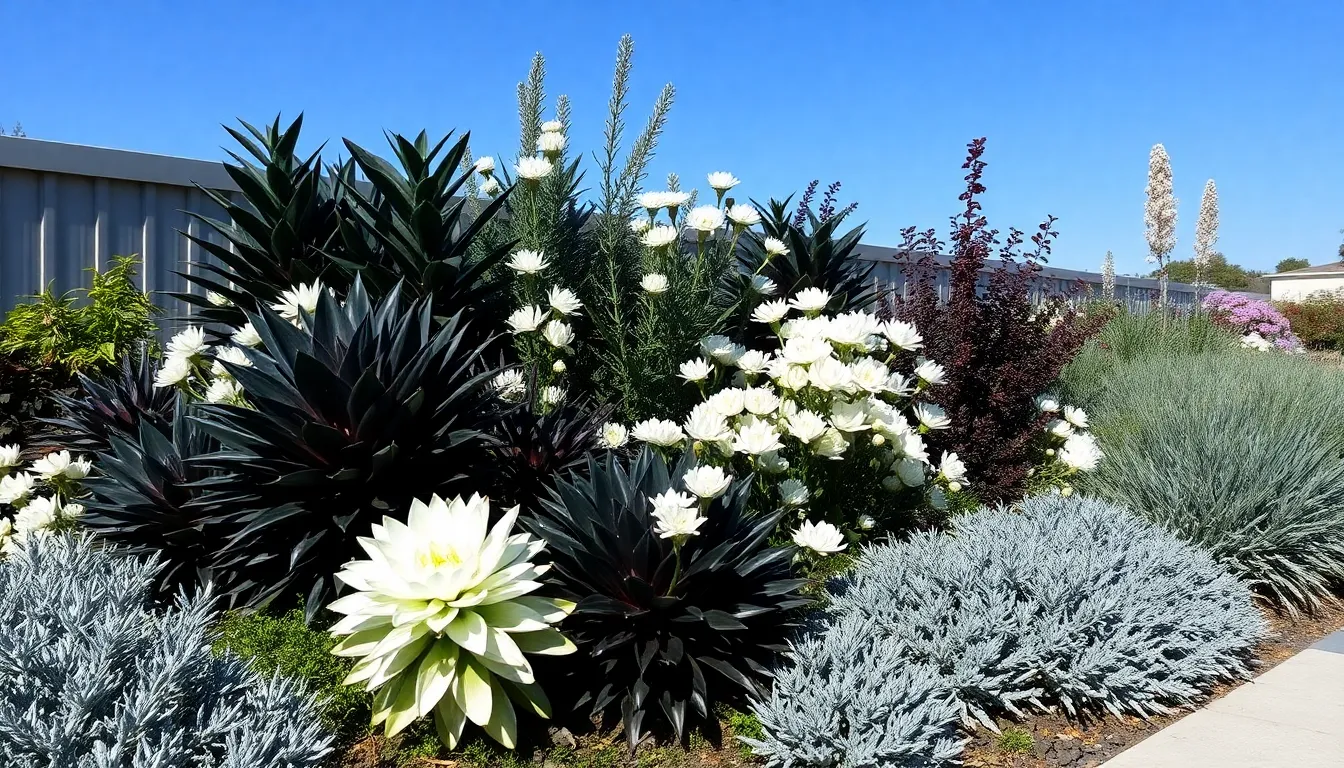
Black and white plant combinations transform outdoor spaces into sophisticated landscapes that command attention year-round. These monochromatic designs create visual drama through striking contrasts while maintaining an elegant, timeless appeal.
Creating Contrast with Dark and Light Foliage
Contrasting dark and light foliage elements forms the foundation of successful black and white garden design. We achieve maximum visual impact by pairing plants with deep burgundy, purple, or brown tones against bright white blooms and silver-gray leaves. Black flowering varieties like chocolate cosmos and black petunias create stunning backdrops for white anemones such as Anemone x hybrida ‘Honorine Joubert’.
Silver-leaf plants like Cerastium tomentosum, commonly known as “Snow in Summer,” amplify the contrast effect when positioned alongside dark-foliaged specimens. Green or silver foliage serves as a transitional element that highlights each color’s intensity while adding textural interest to the composition. Dark plants shouldn’t be placed in deep shade where they’ll blend into the background instead of standing out as focal points.
Seasonal Planting Strategies
Strategic seasonal planning ensures our black and white gardens maintain visual interest throughout the growing season. We combine perennials, annuals, and shrubs with varying bloom times to create continuous color displays from spring through fall. Early season performers like windflowers and snow-in-summer provide white blooms and foliage when gardens are awakening from winter dormancy.
Summer brings peak performance from many black-flowered species, while late-blooming varieties extend the display into autumn months. Evergreen options like the succulent Aeonium ‘Zwartkop’ offer year-round structure and depth, maintaining the garden’s monochromatic theme even during dormant periods. Planning with different blooming periods creates a ever-changing industry that evolves throughout the seasons.
Companion Planting Techniques
Successful companion planting in monochromatic gardens requires selecting plants that share similar growing conditions while maximizing visual contrast. We pair dark-leafed varieties like Aeonium ‘Zwartkop’ with bright white flowers or silver-gray foliage to create ever-changing visual interplay. Plants with different heights, textures, and growth habits add dimensional interest beyond simple color contrast.
Matching cultural requirements ensures all companion plants thrive together in the same garden space. We consider factors like soil moisture, sunlight exposure, and nutrient needs when grouping black and white varieties. Varying plant forms from upright spikes to cascading groundcovers creates layered compositions that showcase each plant’s unique characteristics while maintaining the overall monochromatic theme.
Care Tips for Maintaining Black and White Plants
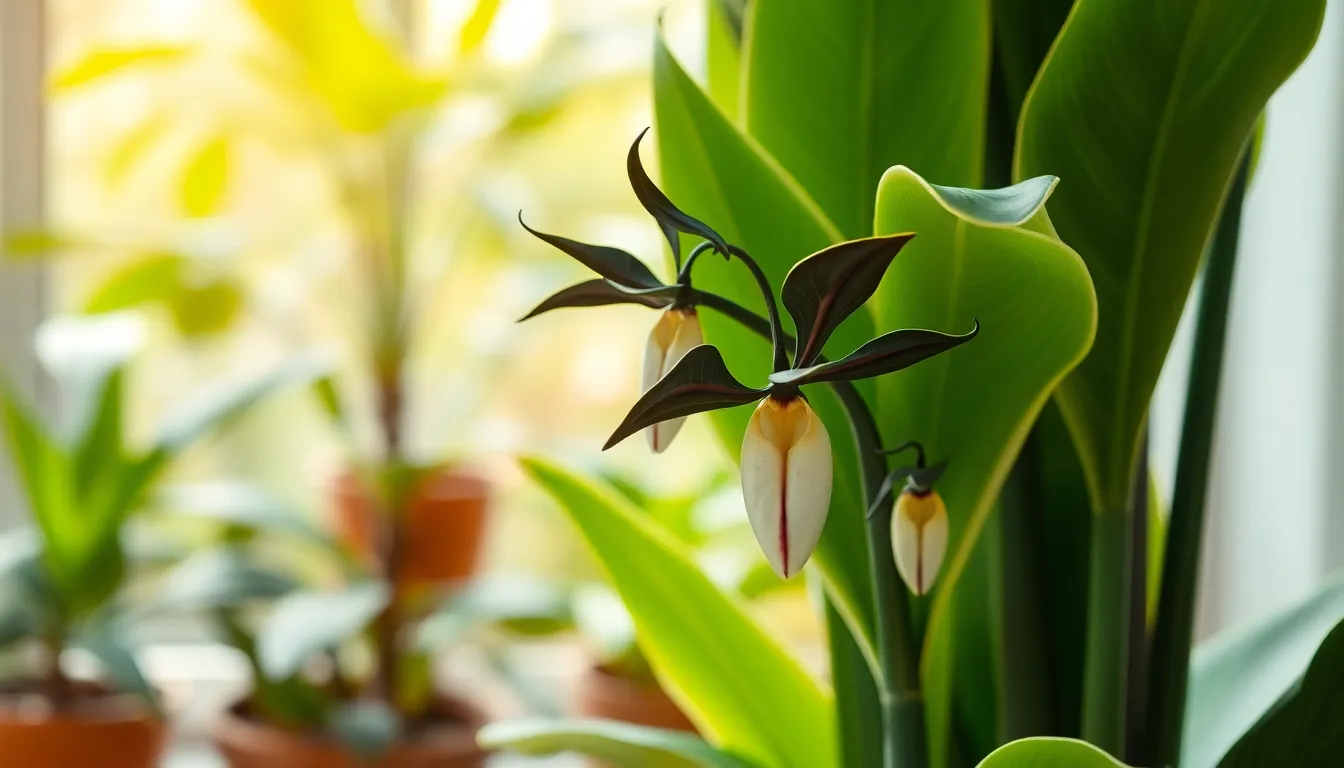
Now that we’ve explored the stunning variety of black and white plants available, let’s jump into the essential care practices that’ll keep these dramatic specimens thriving in your garden and home.
Lighting Requirements for Dark Foliage
Tacca plants demand exact lighting conditions to maintain their striking black and white bat-shaped flowers. These unique specimens prefer low-light environments with approximately 40-60% shade, mimicking their natural rainforest understory habitat. We recommend protecting them from direct sunlight to prevent leaf damage and preserve their dramatic coloration.
Tradescantia varieties flourish in bright, indirect light even though their vibrant foliage patterns. Position these plants near windows with sheer curtains to provide filtered sunlight that won’t scorch their delicate leaves. Direct sun exposure can quickly damage the intricate white and green variegation that makes these plants so appealing.
Aglaonema plants with dark or variegated foliage require careful light management for optimal growth. Bright, indirect light promotes healthy development while preserving their stunning leaf patterns. Low light conditions slow their growth significantly, and direct afternoon sun can fade their beautiful coloration.
Watering Needs for White Flowering Varieties
Tacca plants require consistent moisture during their active growing season while avoiding waterlogged conditions. We suggest watering twice weekly as temperatures rise, ensuring the soil remains evenly moist but never soggy to prevent root rot. These plants need careful attention to their water balance to produce their spectacular white and black blooms.
Tradescantia plants prefer a moderate watering schedule based on soil moisture levels. Water when the top two inches of soil feel dry to the touch, as these plants aren’t heavy drinkers. Regular misting benefits them greatly, especially in low humidity environments where their white variegation can become stressed.
Aglaonema varieties need strategic watering to maintain their health and appearance. We recommend watering when approximately half the soil volume feels dry, then water thoroughly until drainage occurs freely. Always discard excess water from saucers to prevent waterlogging that can damage these beautiful plants.
Soil and Fertilizer Considerations
Tacca plants thrive in well-draining soil mixtures that provide excellent airflow and drainage. We suggest enriching standard potting soil with orchid mix or perlite to create the ideal growing medium. During the growing season, fertilize every two weeks with a balanced 10-20-10 liquid fertilizer to support their dramatic blooms.
Tradescantia plants perform well in general well-draining potting soil without heavy fertilization requirements. These adaptable plants benefit from occasional feeding during their active growth period but don’t demand intensive nutrient schedules. Focus on providing consistent moisture and proper drainage rather than heavy feeding.
Aglaonema plants prefer balanced, well-aerated soil mixtures that support their root development. Moderate fertilization following your regular watering schedule helps maintain healthy growth without overwhelming these relatively low-maintenance plants. We recommend using a balanced fertilizer to support both their foliage and overall plant health.
Where to Find and Purchase Plants Black and White
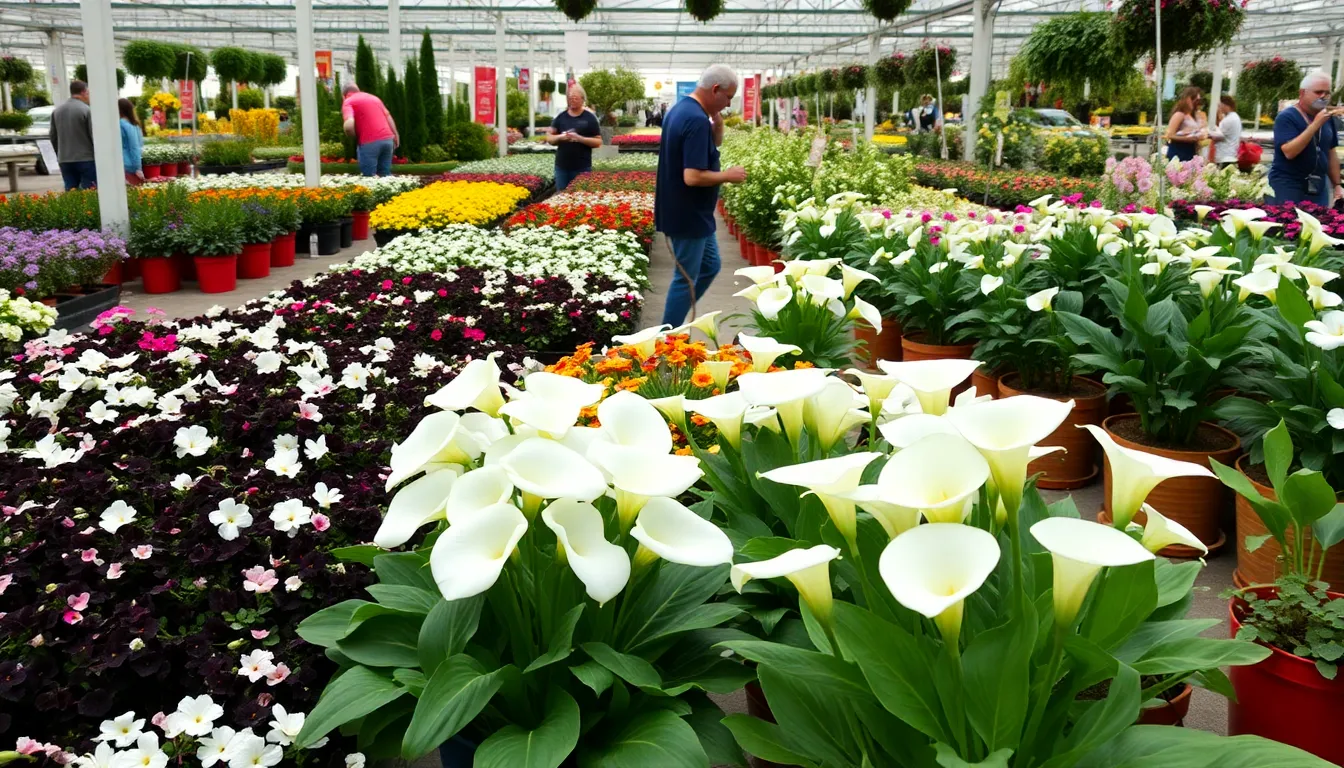
Now that we’ve explored the stunning varieties and care requirements, let’s discover where to source these dramatic plants for your garden and home.
Local Nurseries and Garden Centers
Local nurseries stock the most common black and white flowering plants during peak growing seasons. Visit these establishments in spring and summer to find petunias like ‘Crazytunia Black&White’ and ‘Black Velvet’ varieties readily available. Garden centers typically carry popular annuals such as pansies including ‘Black Accord’ and various calla lily cultivars during their respective seasons.
Many nurseries maintain relationships with specialty growers and can special order unique varieties like Nemophila menziesii ‘Snowstorm’ or Anemone coronaria ‘Carmel White’ if you request them in advance. Staff members at established garden centers often provide valuable growing advice exact to your local climate conditions. Shopping locally allows you to inspect plant quality firsthand and ensures you’re getting healthy specimens that haven’t endured shipping stress.
Online Plant Retailers
Online plant retailers offer the broadest selection of black and white plants year round. Specialized websites like Epic Gardening showcase detailed growing information alongside their plant offerings, helping you make informed purchasing decisions. Digital catalogs feature exotic varieties such as the Black Bat Flower (Tacca chantrieri) that local nurseries rarely stock.
E-commerce platforms provide access to rare cultivars and specialty hybrids from growers across the country. Many online retailers guarantee plant health upon arrival and offer detailed care instructions with each purchase. Seasonal sales and bulk purchasing options make online shopping cost effective for larger garden projects or multiple plant varieties.
Specialty Plant Shows and Markets
Horticultural shows present the most diverse selection of unusual black and white plant varieties. Plant fairs connect you directly with specialty growers who cultivate rare specimens like unique pansy hybrids and exotic perennials. These venues often feature plants that aren’t available through traditional retail channels.
Specialty markets allow you to speak directly with growers about cultivation techniques and exact variety characteristics. Many vendors at plant shows offer pre-order services for seasonal varieties, ensuring you can secure desired plants before they become widely available. Attending these events provides opportunities to discover new cultivars and connect with other gardening enthusiasts who share similar interests in dramatic monochromatic plantings.
Conclusion
We’ve discovered that black and white plants offer endless possibilities for creating sophisticated landscapes that captivate year-round. These dramatic botanicals prove that monochromatic doesn’t mean monotonous – from glossy black foliage to pristine white blooms each variety brings its own unique character to our gardens and homes.
The key to success lies in understanding each plant’s exact needs and combining varieties that thrive in similar conditions. Whether we’re designing indoor spaces with striking ZZ plants and variegated pothos or crafting outdoor gardens with black dahlias and white hydrangeas the results are consistently stunning.
With proper care and thoughtful placement these remarkable plants will transform our spaces into living works of art that showcase nature’s most elegant color palette.
Frequently Asked Questions
What are black and white plants and why are they popular in modern gardens?
Black and white plants are botanical varieties featuring dramatic dark foliage or pure white blooms that create striking visual contrasts. They’re popular because they add sophisticated elegance to contemporary gardens and indoor spaces, offering timeless appeal that complements modern design aesthetics while creating stunning focal points.
Which black foliage plants make the biggest visual impact?
Black Pearl ornamental pepper, Black Elephant Ear (Colocasia ‘Black Magic’), and black dahlia varieties like ‘Black Beauty’ and ‘Black Jack’ create the most dramatic impact. These plants feature deep, dark foliage that commands attention and provides excellent contrast against lighter plants and backgrounds.
What are the best white flowering plants for garden elegance?
Classic white roses, white hydrangeas, and white moonflowers are top choices for timeless garden elegance. These plants offer varied bloom times and textures, creating continuous interest throughout the growing season while maintaining that sophisticated white aesthetic that pairs beautifully with dark foliage plants.
Can black and white plants thrive indoors?
Yes, many black and white plants excel indoors. Black ZZ Plants offer glossy dark leaves with minimal care requirements, while White Pothos varieties like Marble Queen provide stunning variegation. Black and White Prayer Plants (Maranta and Calathea) add dynamic patterns perfect for contemporary home decor.
What are variegated black and white plants?
Variegated black and white plants feature leaves with contrasting light and dark patterns or stripes. Examples include white-striped snake plants and black and white hostas. These plants add sophisticated contrast and visual interest while maintaining the monochromatic theme in garden designs.
How do I design an outdoor garden using black and white plants?
Focus on contrasting dark and light foliage to create visual drama. Use seasonal planting strategies to maintain year-round interest, and employ companion planting techniques by selecting plants with similar growing conditions. This ensures both visual contrast and plant health in your monochromatic landscape.
What are the lighting requirements for black and white plants?
Lighting needs vary by species. Dark foliage plants like Tacca often prefer filtered light, while white flowering varieties may need full sun. Variegated plants like Tradescantia and Aglaonema typically thrive in bright, indirect light. Always research specific requirements for optimal growth and color retention.
Where can I purchase black and white plants?
Local nurseries and garden centers offer common varieties during peak seasons. Online retailers provide broader selections including rare cultivars. Specialty plant shows and markets are excellent for discovering unusual varieties and connecting directly with growers who specialize in these dramatic plants.
Do black and white plants require special care?
While care varies by species, most require attention to moisture balance, proper lighting, and appropriate soil conditions. Dark foliage plants may need protection from intense sun, while white flowering varieties often require consistent watering. Regular fertilizing helps maintain vibrant coloration and healthy growth.
Are monochromatic succulents available in black and white?
Yes, Black Rose Aeonium and White Ghost Plant are excellent examples of monochromatic succulents. These varieties offer unique aesthetics with low maintenance requirements, making them perfect for both indoor and outdoor applications while maintaining the dramatic black and white color scheme.

